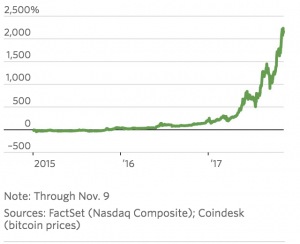Bitcoin has seen remarkable success since its initial launch in August of 2008 at a meagre price of $2, skyrocketing to a price of a record 7,400 USD and up by more than 750% in the past year. However, recent falling prices and instability has caused some serious concern for holders of Bitcoin and those utilizing its flexibility.
Bitcoin operates as what is called a “cryto currency;” which operates via digital asset transactions. Avoiding management and executives and instead utilizing a type of mining process where users “mine” for Bitcoins, has propelled the cost of bitcoin to incredible numbers.

The cornerstone of Bitcoin is in the fact that it is decentralized. Operating without governmental intervention, could be be the double edged sword that dictates this crypto currency’s end game. One major advantage of Bitcoin is in the fact that it doesn’t respond to monetary influences; such as inflation or deflation. Instead, Bitcoin responds exclusively to market demand, moving up and down depending upon what individuals dictate.

Users “mine” to accumulate Bitcoin.
However recent months have lead to some concern for this “crypto currency” as the price has continued to show rapid fluctuation and instability, falling 7 percent just last week. It has become increasingly clear that bitcoin potentially could be sitting on an extraordinary bubble with prices doomed for the ground. Financial leaders such as J.P. Morgan Chase & Co. Chief Executive Jamie Dimon has described bitcoin as a “fraud” that will “blow up.”
The possibility of boom and bust is definitely in play when it comes to Bitcoin, as historically such incredible growth at such a rate has had some devastating effects within the technology industry. Take for example the Dot-com bubble of the 1990’s, where excessive speculation and extreme growth lead to the failure of hundreds of thousands of new internet companies. Even developed companies such as Cisco, fell as much as 86 percent. Something could be similar in the age of these “crypto currencies” as these extreme highs and lows is indicative of what happened a couple decades ago. It will be interesting to see exactly where Bitcoin “falls” in what could be the next couple years, potentially months.
In defence of Bitcoin and its success are some serious competitive advantages are felt relative to traditional currency. Take for example its resistance to counterfeit; this comes back to its virtual nature and intangibility. In addition, all transactions with Bitcoin are irreversible and come cost free, a serious benefit for individuals looking to keep low margins.
The decentralized nature of Bitcoin could be dictating the ebbs and flows that comes with the general market, but evidence from what Bitcoin is experiencing in this period of time in terms of fluctuation, is indicative of disaster that was seen not many years ago.
Media References
https://dataeconomy.com/2017/07/history-of-bitcoin/
https://www.wsj.com/articles/bitcoin-the-worlds-most-dramatic-bubble-ever-1510303095
http://www.dw.com/en/bitcoin-value-falls-dramatically-in-48-hours/a-41332951
All images obtained from free photo sharing site, pixabay.com
Word Count 449







